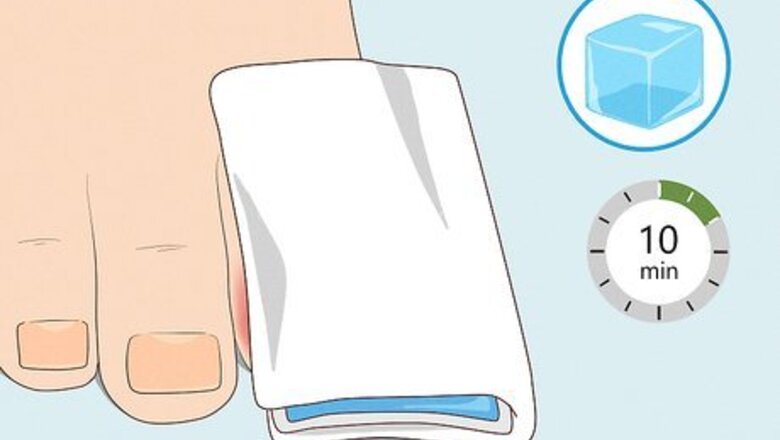
views
- Ice the bruise as soon as possible and keep your foot elevated to reduce swelling and discoloration. Take acetaminophen for pain if needed.
- Limit your physical activity and try saline solution soaks, warm compresses, or remedies like arnica ointment or St John’s Wort oil to speed up healing.
- Keep your toenail trimmed short to prevent further injury.
Treating Pain and Swelling
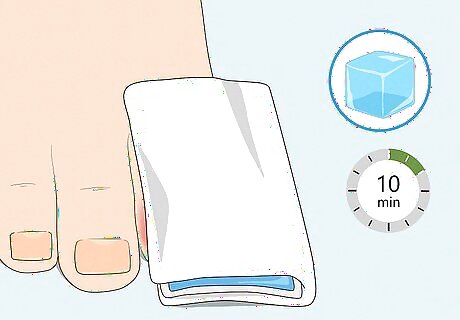
Apply ice to the bruise as soon as possible. Put a towel-wrapped ice pack on your toe for up to 20 minutes at a time on the same day you get a bruise. Take it off after 10 minutes and reapply it after 20 minutes of rest. This will reduce swelling and make the bruise hurt less. Most bruises will fade and heal on their own in 2-4 weeks. Keep an eye on your bruised toe and see a doctor if a bruised toe or toenail doesn’t fade or gets worse after that amount of time. If you don’t have an ice pack, you can use a bag of frozen vegetables wrapped in a clean towel.
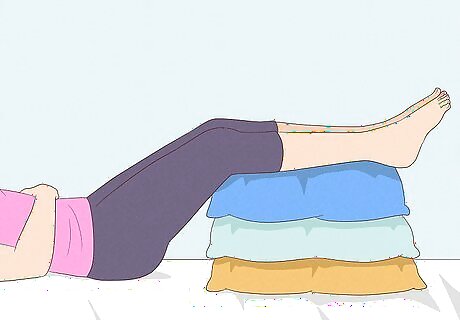
Elevate the toe to reduce blood flow to it. Sit or lie down somewhere where you can put your foot up on something to elevate it above the level of your heart. This will reduce pressure to the bruised area and minimize the swelling. For example, you could lie down on a couch and prop your foot up with a couple of cushions or pillows to elevate the bruised toe above heart level.
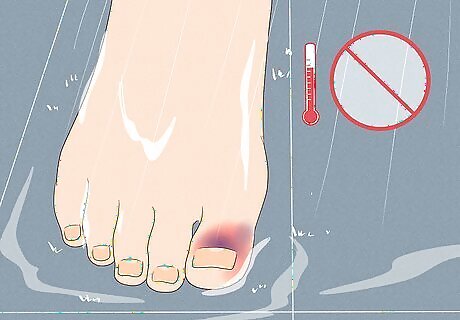
Avoid heating the bruise for 2-3 days. Extreme heat will cause more swelling of the bruised area. Don’t take any particularly hot showers or baths or use warm compresses for the first 2-3 days after you bruise your toe. Applying heat brings more blood to the surface.
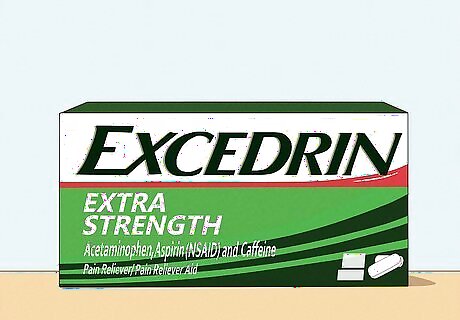
Take painkillers if you need any pain relief. Confirm with your doctor that you can take OTC painkillers for your injury, and double-check which ones are safe to use. Always follow the dosage instructions on the package when taking medication. Painkillers that contain acetaminophen are Tylenol and Excedrin, for example.
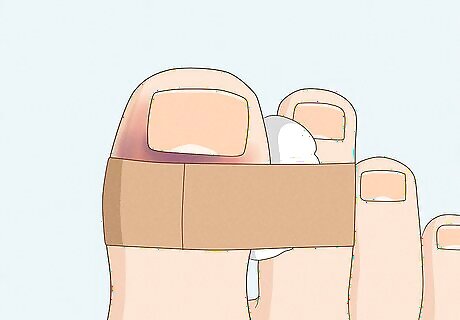
Tape the injured toe to the toe next to it to keep it stable. Put a small cotton ball between the 2 toes; then, wrap medical tape around them to keep your injured toe stable. Change the cotton and tape every day until the swelling goes down. The cotton ball will help absorb moisture between the toes while they are taped together.
Speeding up the Healing Process
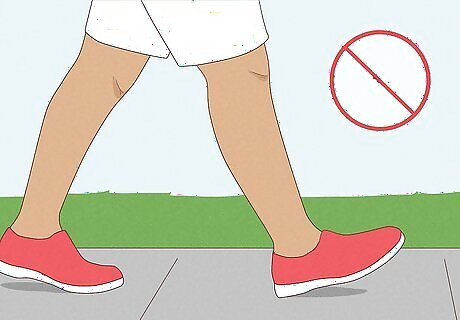
Limit physical activity and pressure on the toe in the days after the injury. Avoid any athletic activity until the bruise starts to fade. Try to avoid putting any strain on it by walking or standing for long periods of time. You can return to regular amounts of walking and physical activity when the swelling is gone. Avoid wearing tight shoes while the toe is healing to keep pressure off it as well. Your doctor might be able to give you shoes with a stiff bottom, which is more accommodating to your injured toe.
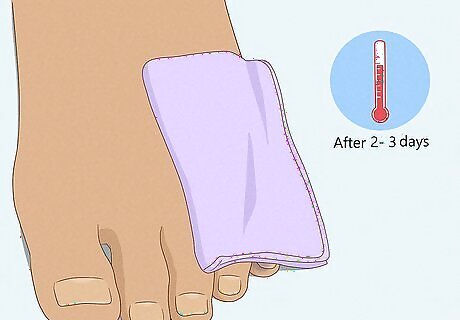
Apply warm compresses to the bruise after 2-3 days. Warm compresses help open up healthy blood vessels and boost healing. Put a warm compress on the toe once a day for 15 minutes. A warm compress is a way to apply heat to part of your body. This can be done in many ways, for example, with warm water, microwaveable pads, hot water bottles, or electric heating pads.
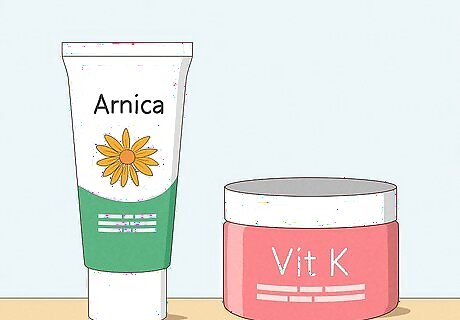
Rub a natural remedy, ointment, or oil on the bruise to help with healing. Apply a small amount of arnica ointment, St. John’s Wort oil, or vitamin K cream to the bruise. Follow the application instructions on the packaging, and always consult a doctor before using any natural remedies. Arnica, when applied topically, may help with bruising. It comes in a variety of topical forms, including oil, ointment, and cream. Don’t take an oral supplement, though, as this can have negative side effects. St. John’s Wort oil to help with injury and pain. Hypericin, one of the active chemicals in this plant, affects your brain’s neurotransmitters. Research shows that vitamin K cream can lessen bruising after certain cosmetic treatments.
Trim your toenail short. The shorter your nails are, the less likely they can grab onto something and get separated from your nail bed. Warning: Toenails are particularly susceptible to fungal infections after an injury. Keep an eye on your nail and visit a doctor if you notice it starting to separate from the skin underneath or if it becomes discolored after the bruise underneath heals. If you trim your toenail flat instead of round, it will also help prevent an ingrown toenail.
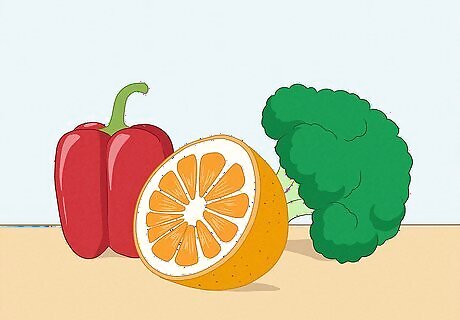
Increase your vitamin C and vitamin K intake. Vitamin C and K are both essential for healing. Get more vitamin C by eating citrus fruits and peppers and get more vitamin K by eating vegetables like broccoli and leafy greens. You can also get more vitamins by taking a multivitamin or supplement every day. Flavonoids also help vitamin C work better in your body, especially when it comes to bruising. Hesperidin (a flavonoid especially helpful with bruising) is plentiful in oranges and lemons.
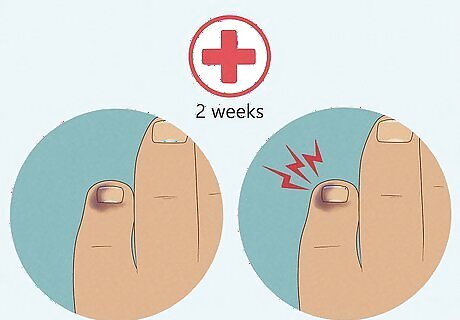
See a doctor if the bruised toe doesn’t seem to be healing after 2-4 weeks. Pain and swelling usually subsides after a few days or a week and bruising usually doesn’t last any longer than 2-4 weeks. Visit a doctor if these symptoms last longer and healing seems to be going slower than normal. Even broken toes can heal on their own at home with the proper care. However, if your toe looks crooked after the injury, it’s a good idea to visit a doctor to make sure it doesn’t need to be straightened to heal properly. If you experience sudden numbness, tingling, or an increase in pain or swelling while the toe is healing during the first 2 weeks, visit a doctor as well.




















Comments
0 comment